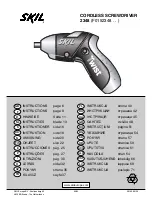
21 Specifications
21.1
Battery
Type:
Lithium-Ion
Designation:
AP
The machine may be operated only with original
STIHL AP rechargeable batteries.
Running time is dependent on the energy con‐
tent of the battery.
21.2
Abrasive wheels
The quoted maximum permissible operating
speed of the abrasive wheel must be greater
than or equal to the maximum spindle speed of
the cut-off machine used.
Max. spindle speed:
6650 rpm
Outside diameter:
230 mm (9 ")
Max. thickness
3 mm
Bore diameter/spindle diameter: 22.23 mm
(7/8 ")
Tightening torque:
20 Nm
(177 lbf. in.)
Composite resin abrasive wheels
Minimum outside diameter of
thrust washers:
80 mm
(3.150 in.)
Max. depth of cut:
70 mm
(2.756 in.)
Diamond abrasive wheels
Minimum outside diameter of
thrust washers:
80 mm
(3.150 in.)
Max. depth of cut:
70 mm
(2.756 in.)
21.3
Weight
without battery, without abrasive
wheel, with water connection
3.9 kg (8.6 lbs.)
21.4
Water supply
Max. pressure of water supply:
4 bar (58 psi)
21.5
Sound and vibration levels
For further details concerning compliance with
the Physical Agents Directive Vibration 2002/44/
EEC, see www.stihl.com/vib/
21.5.1
Values when cutting concrete under
pressure with diamond abrasive wheel
Sound pressure
level L
peq
to
EN 60745-2-22:
103 dB(A)
Sound power level
L
w
to
EN 60745-2-22:
114 dB(A)
Vibration level a
hv,eq
to EN 60745-2-22:
Left handle:
3.5 m/s
2
Sound pressure
level L
peq
to
EN 60745-2-22:
103 dB(A)
Handle, right
3.5 m/s
2
21.5.2
Values when maximum engine speed
without load with diamond abrasive
wheel
Sound pressure
level L
peq
to
EN 60745-2-3:
93 dB(A)
Sound power level
L
w
to EN 60745-2-3:
104 dB(A)
21.5.3
Values when maximum engine speed
without load with composite resin
abrasive wheel
Sound pressure
level L
peq
to
EN 60745-2-3:
72 dB(A)
Sound power level
L
w
to EN 60745-2-3:
83 dB(A)
The vibration values quoted above have been
measured according to a standardized test pro‐
cedure and may be used to compare electric
power tools.
Depending on the type of usage, the vibrations
that actually occur may differ from the values
quoted.
The vibration values quoted may be used for an
initial assessment of the user's exposure to
vibrations.
The actual exposure to vibrations has to be eval‐
uated. This process may also take into account
times during which the electric power tool is
switched off and times during which it is switched
on but running without load.
Observe measures to reduce vibration exposure
to protect the user – see section on "Vibrations"
in chapter on "Safety Precautions and Working
Techniques".
The K‑factor in accordance with Directive
2006/42/EC is 2.0 dB(A) for the sound pressure
level and sound power level; the K‑factor in
accordance with Directive 2006/42/EC is
2.0 m/s
2
for the vibration level.
21.6
Transporting
STIHL rechargeable batteries comply with the
requirements stipulated in UN‑Manual Tests and
Criteria, Part III, Subsection 38.3.
English
21 Specifications
58
0458-707-9621-B
















































